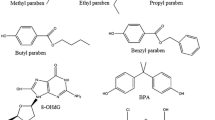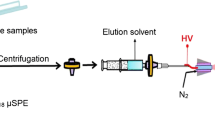Abstract
Phthalates, bisphenol A (BPA) and parabens (PBs), organic chemicals widely used in everyday products, are considered to be endocrine disruptors. We propose a liquid chromatography–tandem mass spectrometry (LC-MS/MS) method for the determination of seven phthalate metabolites, six PBs and BPA in human urine. All three categories of the above endocrine disruptors were simultaneously extracted from 1 mL of human urine using solid phase extraction. In addition, with a conventional reversed phase LC column, we achieved for the first time the separation of three pairs of structural isomers, namely iso-/n-butyl paraben, propyl paraben and monobutyl phthalate. LC-MS/MS was operated and tested in both electrospray ionisation (ESI) and atmospheric pressure chemical ionisation (APCI). ESI was selected for the analysis due to its superior stability and repeatability. The method limit of detection (mLOD), achieved for a single set of high-performance LC conditions, ranged from 0.01 to 0.84 ng/mL for phthalate metabolites, from 0.06 to 0.24 ng/mL for PBs and was 2.01 ng/mL for BPA. Derivatisation of BPA with dansyl chloride lowered its mLOD to 0.007 ng/mL. Blank contamination was non-detectable. The present method was successfully applied for the analysis of the above-mentioned compounds in 80 male human urine samples.



Similar content being viewed by others
References
State of the science of endocrine disrupting chemicals (2012) World Health Organization Available. http://www.who.int/ceh/publications/endocrine/en/. Accessed 09 Sept 2014
Diamanti-Kandarakis E, Bourguignon JP, Giudice LC, Hauser R, Prins GS, Soto AM, Zoeller RT, Gore AC (2009) Endocrine-disrupting chemicals: an Endocrine Society scientific statement. Endocr Rev 30(4):293–342. doi:10.1210/er.2009-0002
Endocrine disruptors (2010) National Institute of Health, U.S Department of Health and Human Services, USA. https://www.niehs.nih.gov/health/materials/endocrine_disruptors_508.pdf. Accessed 19 Sept 2014
Chapin RE, Adams J, Boekelheide K, Gray LE Jr, Hayward SW, Lees PS, McIntyre BS, Portier KM, Schnorr TM, Selevan SG, Vandenbergh JG, Woskie SR (2008) NTP-CERHR expert panel report on the reproductive and developmental toxicity of bisphenol A. Birth Defects Res B Dev Reprod Toxicol 83(3):157–395. doi:10.1002/bdrb.20147
Burridge E (2003) Bisphenol A: product profile. Eur Chem News 17:14–20
Crinnion WJ (2010) Toxic effects of the easily avoidable phthalates and parabens. Altern Med Rev 15(3):190–196
Elder RL (1984) The cosmetic ingredient review—a safety evaluation program. J Am Acad Dermatol 11(6):1168–1174
ATSDR (1995) Toxicological profile for diethylphthalate. Agency for Toxic Substances and Disease Registry, Public Health Service Atlanta, Department of Health and Human Services, GA, USA. http://www.atsdr.cdc.gov/toxprofiles/tp73.pdf. Accessed 09 Sept 2014
ATSDR (2001) Toxicological profile for di-n-butyl phthalate. Agency for Toxic Substances and Disease Registry, Public Health Service Atlanta, Department of Health and Human Services, GA US. http://www.atsdr.cdc.gov/toxprofiles/tp135.pdf. Accessed 09 Sept 2014
ATSDR (2002) Toxicological profile for di(2-ethylhexyl)phthalate(DEHP). Agency for Toxic Substances and Disease Registry, Public Health Service Atlanta, Department of Health and Human Services, GA, US. http://www.atsdr.cdc.gov/toxprofiles/tp9.pdf. Accessed 09 Sept 2014
Soni MG, Burdock GA, Taylor SL, Greenberg NA (2001) Safety assessment of propyl paraben: a review of the published literature. Food Chem Toxicol 39(6):513–532
Meeker JD (2010) Exposure to environmental endocrine disrupting compounds and men’s health. Maturitas 66(3):236–241. doi:10.1016/j.maturitas.2010.03.001
Duty SM, Calafat AM, Silva MJ, Ryan L, Hauser R (2005) Phthalate exposure and reproductive hormones in adult men. Hum Reprod 20(3):604–610. doi:10.1093/humrep/deh656
CDC (2012) Fourth national report on human exposure to environmental chemicals. Updated tables. Centers for Disease Control and Prevention, National Center for Environmental Health, Division of Laboratory Sciences, Atlanta, GA, USA. http://www.cdc.gov/exposurereport/pdf/FourthReport_UpdatedTables_Sep2012.pdf. Accessed 09 Sept 2014
Wormuth M, Scheringer M, Vollenweider M, Hungerbuhler K (2006) What are the sources of exposure to eight frequently used phthalic acid esters in Europeans? Risk Anal 26(3):803–824. doi:10.1111/j.1539-6924.2006.00770.x
Calafat AM, Ye X, Silva MJ, Kuklenyik Z, Needham LL (2006) Human exposure assessment to environmental chemicals using biomonitoring. Int J Androl 29(1):166–171. doi:10.1111/j.1365-2605.2005.00570.x, discussion 181-165
EEC, European Commission SCF/CS/PM/3936. Opinion of the Scientific Committee on Food on Bisphenol A. (2002). http://ec.europa.eu/food/fs/sc/scf/out128_en.pdf. Accessed 09 Sept 2014
Staples CA, Dorn PB, Klecka GM, O’Block ST, Harris LR (1998) A review of the environmental fate, effects, and exposures of bisphenol A. Chemosphere 36(10):2149–2173
Wetherill YB, Petre CE, Monk KR, Puga A, Knudsen KE (2002) The xenoestrogen bisphenol A induces inappropriate androgen receptor activation and mitogenesis in prostatic adenocarcinoma cells. Mol Cancer Ther 1(7):515–524
Lang IA, Galloway TS, Scarlett A, Henley WE, Depledge M, Wallace RB, Melzer D (2008) Association of urinary bisphenol A concentration with medical disorders and laboratory abnormalities in adults. JAMA 300(11):1303–1310. doi:10.1001/jama.300.11.1303
Kim YH, Kim CS, Park S, Han SY, Pyo MY, Yang MH (2003) Gender differences in the levels of bisphenol A metabolites in urine. Biochem Biophys Res Commun 312(2):441–448. doi:10.1016/j.bbrc.2003.10.135
Soni MG, Carabin IG, Burdock GA (2005) Safety assessment of esters of p-hydroxybenzoic acid (parabens). Food Chem Toxicol 43(7):985–1015. doi:10.1016/j.fct.2005.01.020
Byford JR, Shaw LE, Drew MG, Pope GS, Sauer MJ, Darbre PD (2002) Oestrogenic activity of parabens in MCF7 human breast cancer cells. J Steroid Biochem Mol Biol 80(1):49–60
Perez P, Pulgar R, Olea-Serrano F, Villalobos M, Rivas A, Metzler M, Pedraza V, Olea N (1998) The estrogenicity of bisphenol A-related diphenylalkanes with various substituents at the central carbon and the hydroxy groups. Environ Health Perspect 106(3):167–174
Wang LQ, James MO (2006) Inhibition of sulfotransferases by xenobiotics. Curr Drug Metab 7(1):83–104
Ye XY, Bishop AM, Reidy JA, Needham LL, Calafat AM (2006) Parabens as urinary biomarkers of exposure in humans. Environ Health Perspect 114(12):1843–1846. doi:10.1289/Ehp.9413
de Wildt SN, Kearns GL, Leeder JS, van den Anker JN (1999) Glucuronidation in humans—pharmacogenetic and developmental aspects. Clin Pharmacokinet 36(6):439–452. doi:10.2165/00003088-199936060-00005
Silva MJ, Barr DB, Reidy JA, Kato K, Malek NA, Hodge CC, Hurtz D, Calafat AM, Needham LL, Brock JW (2003) Glucuronidation patterns of common urinary and serum monoester phthalate metabolites. Arch Toxicol 77(10):561–567. doi:10.1007/s00204-003-0486-3
Cashman AL, Warshaw EM (2005) Parabens: a review of epidemiology, structure, allergenicity, and hormonal properties. Dermatitis: Contact Atopic Occup Drug 16(2):57–66, quiz 55-56
Flexar SQ 300 MS. A reference notebook of LC/SQ MS Applications—second edition, Perkin Elmer Brochure (2011) Santa Clara, CA, USA. http://shop.perkinelmer.com/content/applicationnotes/BKT_FlexarSQ300Applications.pdf. Accessed 09 Sept 2014
Laboratory procedure manual, Method No. 6301.01 (2009) Centers for Disease Control and Prevention, National Center for Environmental Health, Division of Laboratory Sciences, Atlanta, GA, USA. http://www.cdc.gov/nchs/data/nhanes/nhanes_05_06/eph_d_met_phenols_parabens.pdf Accessed 09 Sept 2014
Silva MJ, Slakman AR, Reidy JA, Preau JL, Herbert AR, Samandar E, Needham LL, Calafat AM (2004) Analysis of human urine for fifteen phthalate metabolites using automated solid-phase extraction. J Chromatogr B 805(1):161–167. doi:10.1016/j.jchromb.2004.02.038
Silva MJ, Malek NA, Hodge CC, Reidy JA, Kato K, Barr DB, Needham LL, Brock JW (2003) Improved quantitative detection of 11 urinary phthalate metabolites in humans using liquid chromatography-atmospheric pressure chemical ionization tandem mass spectrometry. J Chromatogr B 789(2):393–404. doi:10.1016/S1570-0232(03)00164-8
Dewalque L, Pirard C, Dubois N, Charlier C (2014) Simultaneous determination of some phthalate metabolites, parabens and benzophenone-3 in urine by ultra high pressure liquid chromatography tandem mass spectrometry. J Chromatogr B 949:37–47. doi:10.1016/j.jchromb.2014.01.002
Silva MJ, Samandar E, Preau JL Jr, Reidy JA, Needham LL, Calafat AM (2007) Quantification of 22 phthalate metabolites in human urine. J Chromatogr B Anal Technol Biomed Life Sci 860(1):106–112. doi:10.1016/j.jchromb.2007.10.023
Ye X, Kuklenyik Z, Needham LL, Calafat AM (2005) Quantification of urinary conjugates of bisphenol A, 2,5-dichlorophenol, and 2-hydroxy-4-methoxybenzophenone in humans by online solid phase extraction-high performance liquid chromatography-tandem mass spectrometry. Anal Bioanal Chem 383(4):638–644. doi:10.1007/s00216-005-0019-4
Chen M, Tao L, Collins EM, Austin C, Lu CS (2012) Simultaneous determination of multiple phthalate metabolites and bisphenol-A in human urine by liquid chromatography-tandem mass spectrometry. J Chromatogr B 904:73–80. doi:10.1016/j.jchromb.2012.07.022
Silva MJ, Slakman AR, Reidy JA, Preau JL Jr, Herbert AR, Samandar E, Needham LL, Calafat AM (2004) Analysis of human urine for fifteen phthalate metabolites using automated solid-phase extraction. J Chromatogr B Anal Technol Biomed Life Sci 805(1):161–167. doi:10.1016/j.jchromb.2004.02.038
Frederiksen H, Nielsen JK, Morck TA, Hansen PW, Jensen JF, Nielsen O, Andersson AM, Knudsen LE (2013) Urinary excretion of phthalate metabolites, phenols and parabens in rural and urban Danish mother–child pairs. Int J Hyg Environ Health 216(6):772–783. doi:10.1016/j.ijheh.2013.02.006
Fox SD, Falk RT, Veenstra TD, Issaq HJ (2011) Quantitation of free and total bisphenol A in human urine using liquid chromatography-tandem mass spectrometry. J Sep Sci 34(11):1268–1274. doi:10.1002/jssc.201100087
Wang HX, Wang B, Zhou Y, Jiang QW (2013) Rapid and sensitive analysis of phthalate metabolites, bisphenol A, and endogenous steroid hormones in human urine by mixed-mode solid-phase extraction, dansylation, and ultra-performance liquid chromatography coupled with triple quadrupole mass spectrometry. Anal Bioanal Chem 405(12):4313–4319. doi:10.1007/s00216-013-6779-
Acknowledgments
We thank Professor Spiros Pergantis (Environmental Chemical Processes Laboratory, University of Crete) for critically reading and commenting our manuscript. This study was supported by the European Union funded project ENVIROGENOMARKERS (FP7-ENV-2008-1, Grant Agreement No. 226756).
Conflict of interest
The authors declare that they have no conflicts of interest.
Compliance with ethical standards
All participants were provided written, informed consent for themselves after having received a complete description of the study, which was approved by the Ethics Committee of the University Hospital in Heraklion, Greece.
Author information
Authors and Affiliations
Corresponding author
Electronic supplementary material
Below is the link to the electronic supplementary material.
ESM 1
(PDF 13 kb)
Rights and permissions
About this article
Cite this article
Myridakis, A., Balaska, E., Gkaitatzi, C. et al. Determination and separation of bisphenol A, phthalate metabolites and structural isomers of parabens in human urine with conventional high-pressure liquid chromatography combined with electrospray ionisation tandem mass spectrometry. Anal Bioanal Chem 407, 2509–2518 (2015). https://doi.org/10.1007/s00216-015-8497-5
Received:
Revised:
Accepted:
Published:
Issue Date:
DOI: https://doi.org/10.1007/s00216-015-8497-5




